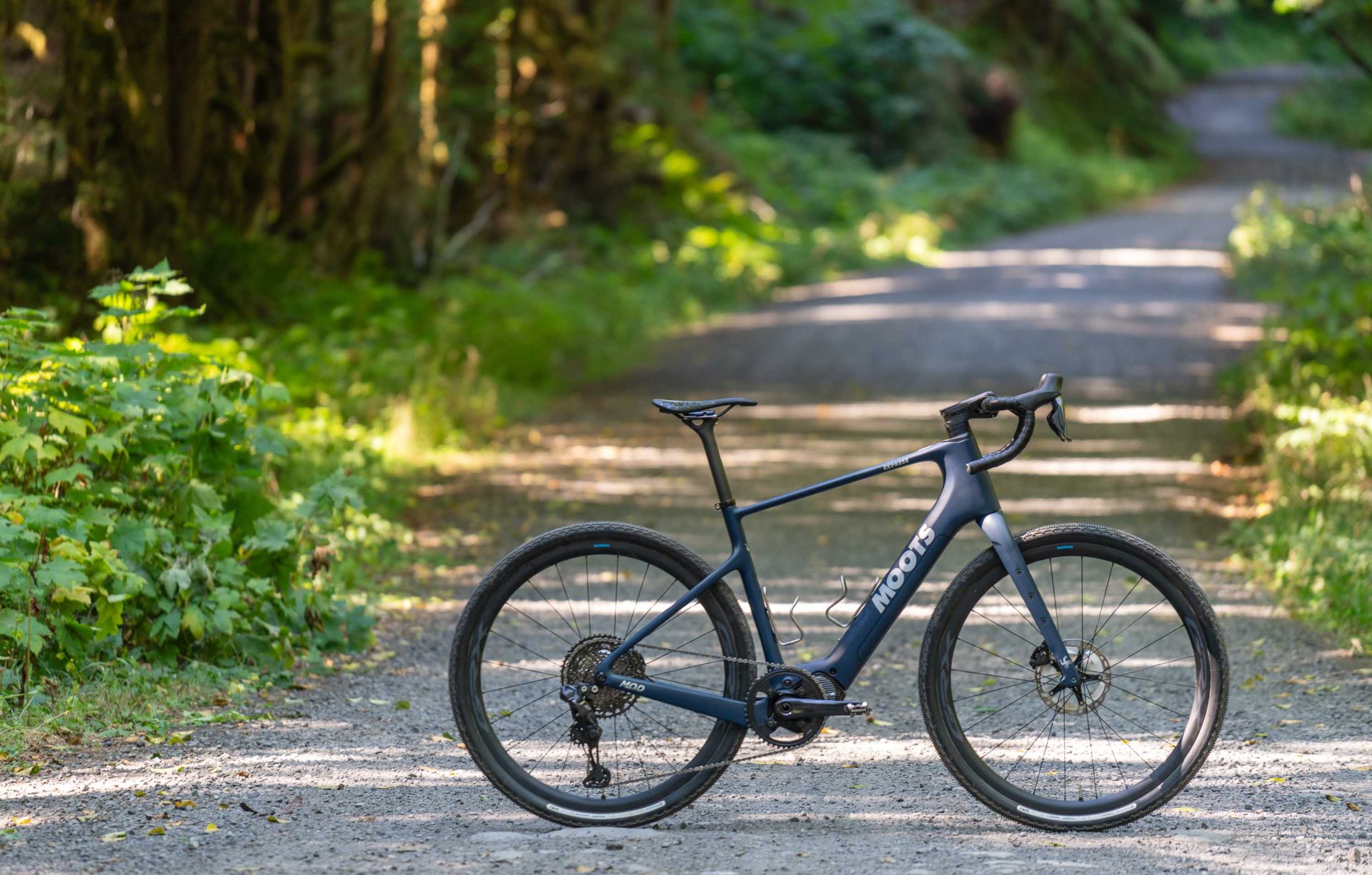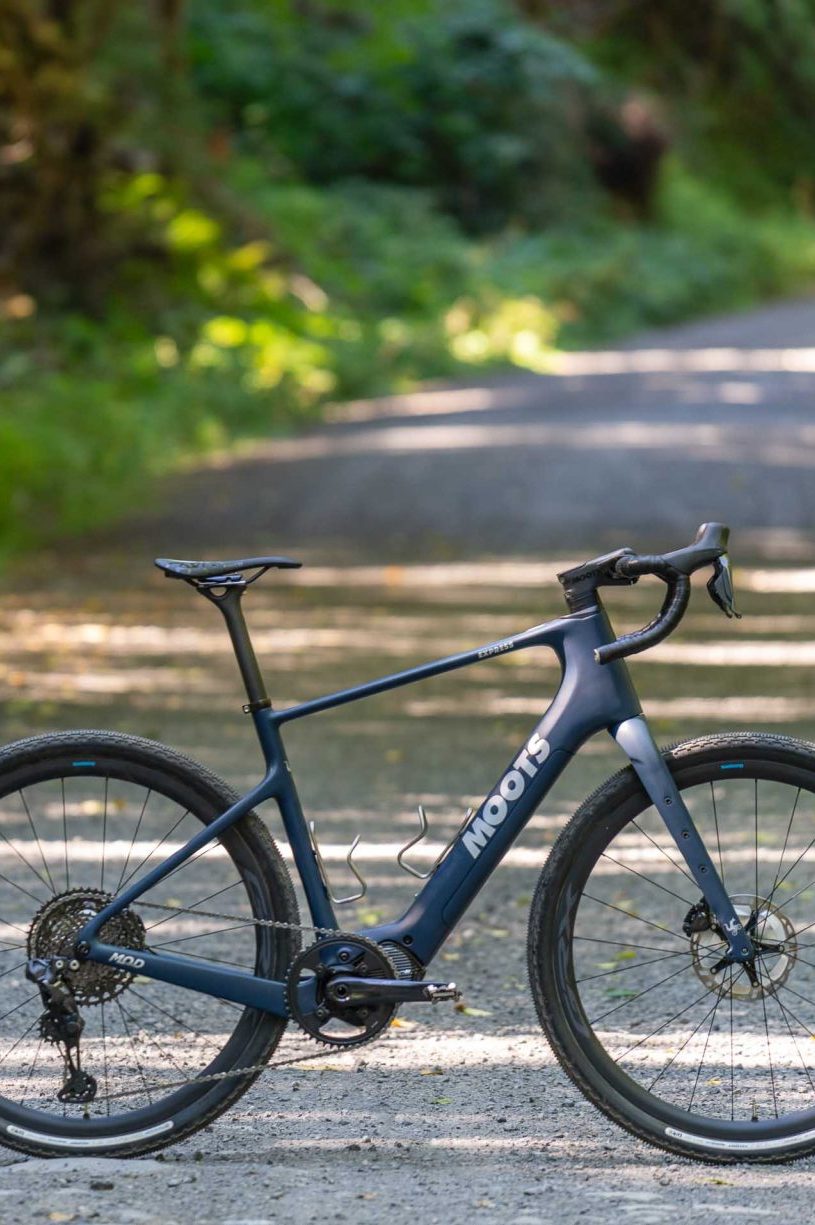Moots has today announced what is likely its most ambitious bike to date. It’s not a some mega-aero road racing bike or a hyper-lux cargo bike. It’s definitely not a titanium tandem or recumbent or unicycle.
In fact, it’s not titanium at all.
The new Express is Moots’ first-ever carbon fiber offering, and it’s an e-gravel bike. On paper, it seems perfectly competitive – perhaps even better than that, in fact. It’s powered by Shimano’s excellent EP801 mid-drive motor system, and the 504 Wh battery hidden inside the down tube will supposedly power it “well past 100 miles” (161 km) while delivering up to 60 Nm of torque (tuned down from the theoretical maximum of 85 Nm for this motor unit). There’s a full Shimano build kit, including GRX carbon wheels (wrapped with 50 mm-wide Panaracer GravelKing+ tires “with clearance to spare”), and a 1×11 Di2 electronic drivetrain with a wide-range 11-50T cassette in the company’s more durable LinkGlide design.
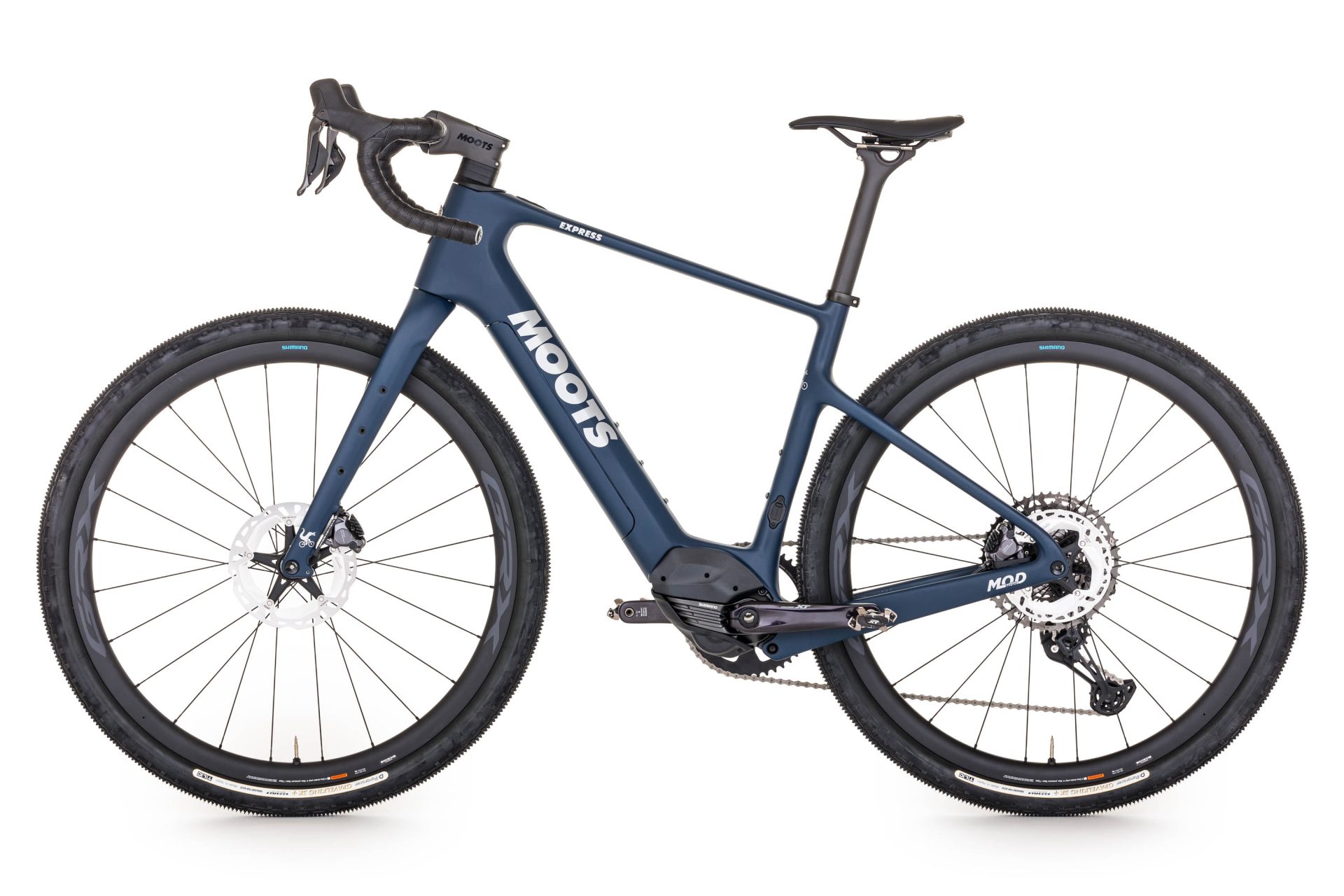
You can even have the system shift for you if you’d like, and the mid-drive motor system is cleanly integrated. While the right-hand shifter controls the rear derailleur as usual, the left-hand shifter allows riders to quickly and easily switch assist modes. A small bar-mounted LCD display sits next to the stem, and there’s also a discreet master power switch and five-bar battery life indicator built into the top tube.
Naturally, wire and brake hose routing are fully hidden courtesy of Moots’ in-house MOD component range, including a carbon fiber stem and flared carbon fiber handlebar rotating around a lovely Chris King headset. Sitting atop the two-bolt carbon fiber seatpost is a WTB Gravelier saddle emblazoned with Moots’ iconic alligator logo.
As for mounts, the Express seems to be somewhat reasonably outfitted, including two bottle mounts in the usual spots, three-pack mounts on the fork blades, and front and rear fender mounts, but that’s it. This clearly isn’t meant to be a heavy-duty bikepacking machine, and so be it.

Moots says a complete Express will tip the scales at an impressive 15 kg (33 lb), and retail price is US$10,000 (it’ll only be available in the US for now).
All in all, it seems like the Moots Express will be a capable competitor in the growing e-gravel bike space.
And it also feels like a monumental mistake.
Decades of investment
Moots’ PR agency distributed to media a carefully crafted press release, but I couldn’t help but notice a conspicuous lack of information regarding the frame itself, which in and of itself strikes me as a red flag.
Founded in 1981 by Kent Eriksen in the mountain town of Steamboat Springs, Colorado, Moots has always been about the frame – and titanium frames, to be specific (at least for the past 30 years or so). It’s been about the craftsmanship and ride quality. Premium titanium materials. A classic aesthetic with round tubing, more recently augmented with cutting-edge 3D-printing technology. And through it all, of course, those impossibly perfect welds.
Aside from the logo on the down tube, I’m just not seeing anything in the Express that identifies it as a Moots.
How’s it made? Where’s it made? What’s the philosophy behind the design? Why does it look the way that it does? What’s it weigh? It’s a carbon fiber frame with seemingly so few distinguishing features that the company’s own press release doesn’t bother to highlight any.
None of those things are mentioned, and it was only because I asked that it was confirmed the Express is made in Asia. To be clear, I think there’s absolutely nothing wrong with making frames in Asia, and Moots says it’s the same manufacturing partners that already produces its forks and components.
However, this isn’t supposed to be just any other frame; it’s a MOOTS.
If you go to the Moots web site (which may or may not have been changed by the time you read this), the company seems very clear about who it is, and what it does.
“Our long-term dedication to one material, titanium, has provided Moots with a level of experience designing, building and riding every style of bike over the past 40 years.”
“Moots is a company of titanium manufacturing specialists and riders.”
“We know titanium. Our design team has a combined 65 years of experience tuning titanium bike designs for optimal performance, comfort and durability.”
And to hammer the point home, here’s the brand’s mission statement: “To foster a true, life-long relationship between bike, rider, and route by creating the highest-quality titanium frame bikes on the planet.” (Emphasis mine)
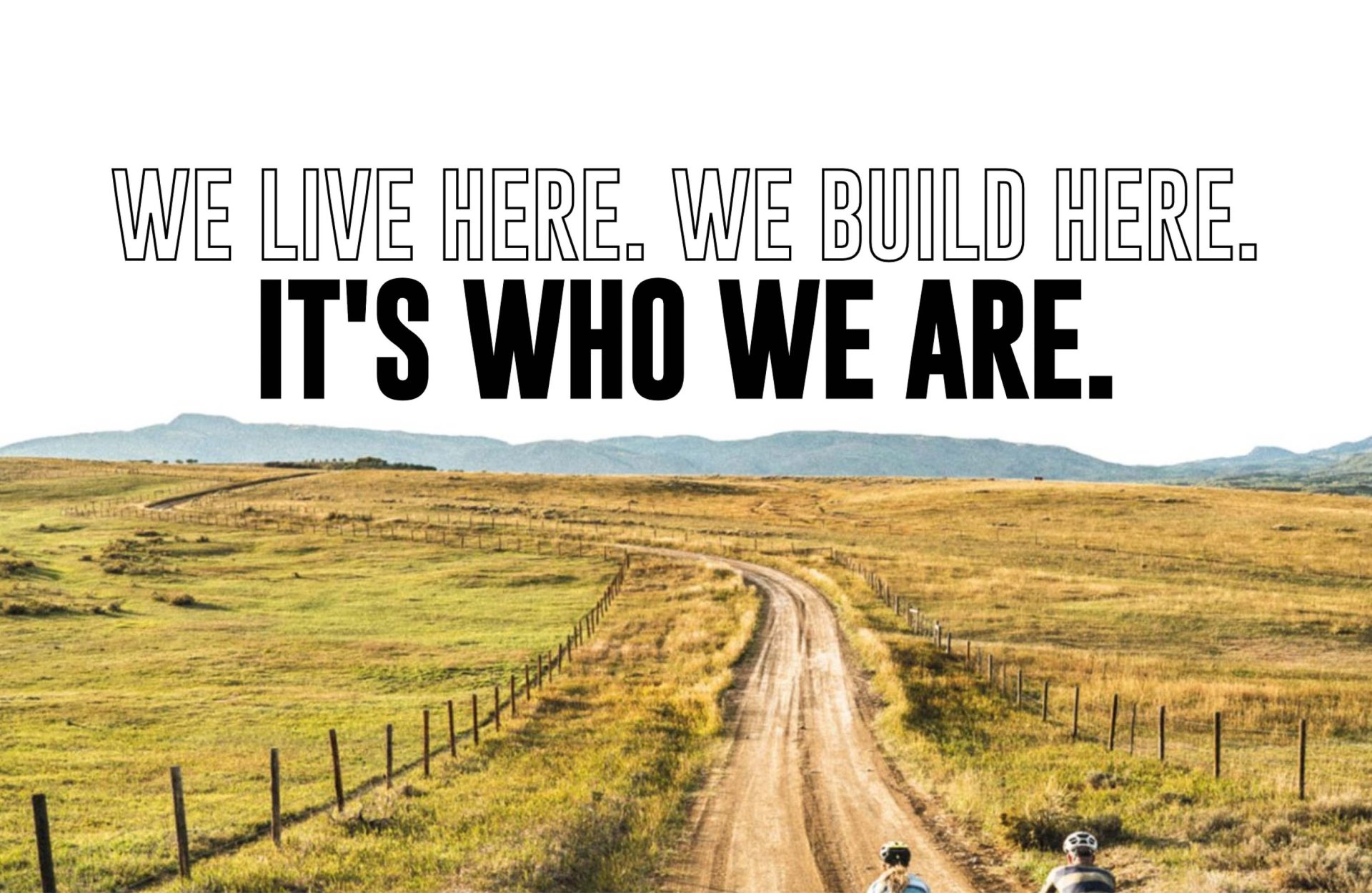

Diving further into the Moots web site, you’ll find painstaking detail about why the company considers its titanium frames special: the experience of its staff, the sourcing of the tubing, the butting, the mitering, the double-pass welds, and so on. You truly get a sense – and rightfully so – that Moots knows titanium the way the rest of us know how to breathe. Malcolm Gladwell would be proud.
Naturally, I posed my questions about the Express frame to the folks at Moots, hoping for some clarity on how this came to be, and why it’s the bike it is. And unfortunately, the answers I received back come across (at least to me) as awfully … corporate.
On whether the Express could have been launched under a new, sister label so as to preserve the sanctity of the Moots brand:
“Of course, we thought about and discussed deeply branching this bike off as the start of a sister company. Ultimately, the Express compliments our existing five gravel models quite well and really rounds out the Moots lineup. Having Moots on the down tube of this bike symbolizes the message to all of our customers that the team they believe in, Moots, was committed to this bike from the ground up and now is delivering a final product that we (Moots) stand behind proudly as we have with all other models over the past forty years. We are a small team and are always working on developing and refining the bikes that we offer. There are always going to be projects that take our focus; some may never see the light of day. All in all, we have to be strategic in managing our direction and make smart decisions about what joins the Moots family.”
On what makes the Express a “Moots”:
“If you look around our small team here at Moots, you will see that everyone here shares a common bond, that being the love for riding bikes. The spirit of who the brand is does not end at cutting metal, welding tubes together, and making nice-looking bikes; we all love riding bikes. We developed the Express from start to finish. It has been a three-year project of ours from conceptualizing the target to being able to deliver to our customers. We hope at this point we are seen as more than just a Ti frame builder, and to be seen for what we really are: a group of very passionate and skilled individuals who are fortunate to come together in a unified manner to push the industry ahead and build world-class complete bikes.”
And on why Moots felt the need for a bike like the Express in the first place:
“We have heard from our longtime dealers and trustworthy customers feedback asking Moots to make a gravel e-bike. We have an industry-leading gravel lineup consisting of five unique models that allow a customer anywhere in the world to have an option for their ‘gravel’ conditions within the Moots lineup. The one bike that we were aware of that was missing in this space, was the gravel e-bike.
“From our internal scope, we have seen an industry shift of a lot of development focus coming towards the e-mobility space and less and less coming to the analog side. Recent examples of Shimano making Di2 mountain bike parts available for e-bikes only, more robust/heavier-built parts like the [SRAM] T-Type derailleurs or the [Shimano] Linkglide accessories. Exposure to this raised awareness of potential long-term trends.
“At the height of the pandemic boom we had a six-month backlog; that window carried on for nearly two years. Our engineering and development were freed up to pull away more than ever before from Ti model improvements and focus on other avenues that we wanted to explore. We were motivated to continue to be leaders in the gravel space, from the racier end of the envelope with Routt CRD and Routt RSL, to the all-around gravel models, Routt 45 and Routt YBB, out to the adventure-hearted Routt ESC. We now can proudly introduce our e-gravel bike, the Express.”
Cashing in?
My visceral reaction to this news can probably be traced back to my long-held admiration and reverence for the brand. I doubt I’m alone in this view, but I grew up lusting after a Moots, reading wistfully about them on magazine pages and web sites, longing to even just see one in person. Never would I thought I’d actually get to ride one, and I still regret not selling a kidney so I could buy the Routt RSL I reviewed years ago.
Perhaps therein lies the problem, though.
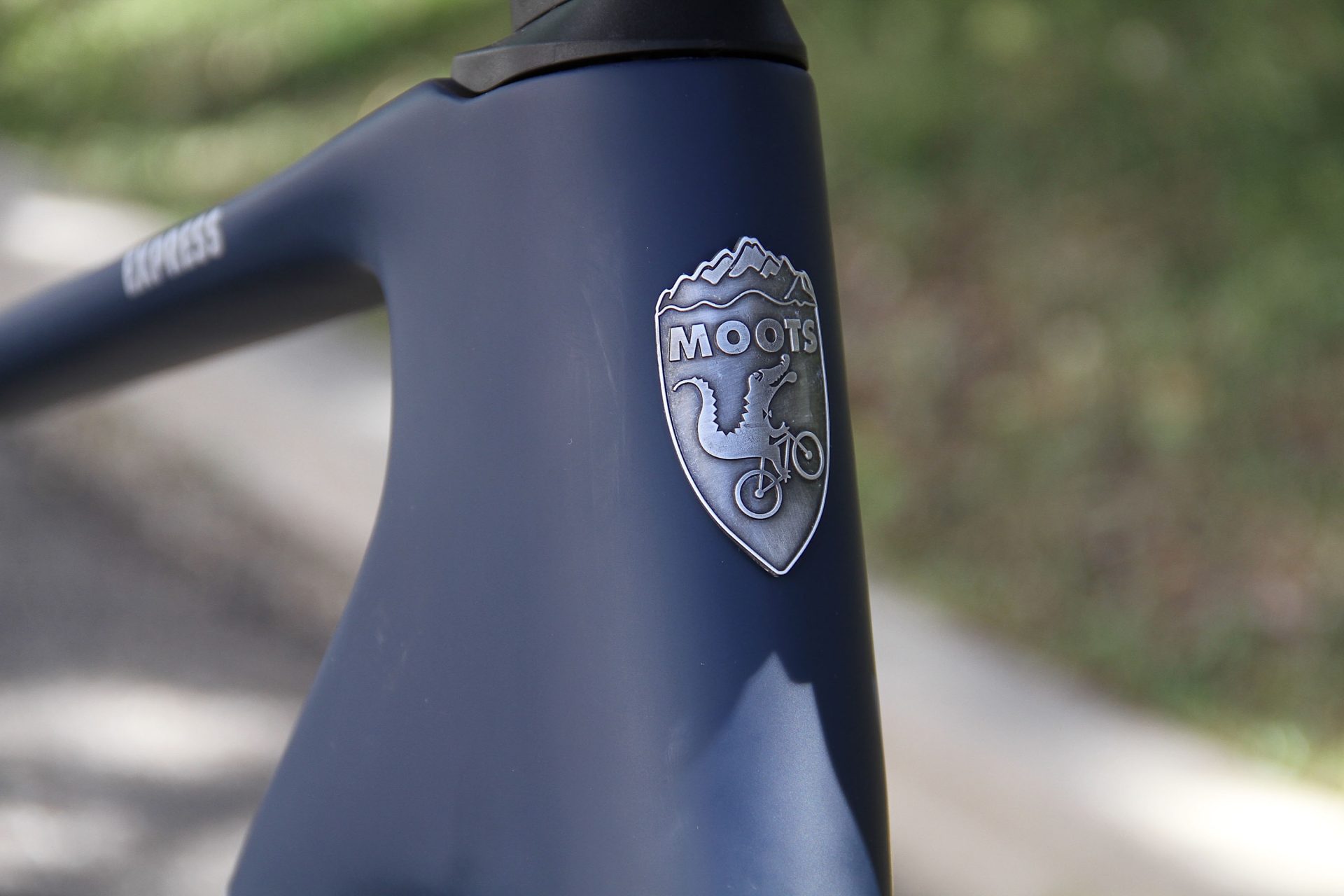
Good titanium frames are never inexpensive, and the sort of mystique that Moots deals in unfortunately comes with a price that’s simply out of reach for most cyclists. Moots’ demographic is almost certainly folks in the prime of their earning years – i.e. well into their 40s, 50s, or more – and with the realities of wealth inequality being what they are, it’s unlikely the typical Moots buyer will trend younger any time soon.
As such, it makes sense for Moots to add an e-bike to its range. But why couldn’t it have been a titanium e-bike? Wouldn’t that have made (a lot) more sense?
Not really, at least based on what I’ve been told. Supposedly, a titanium frame sufficiently reinforced to handle the torque and weight of all that e-bike gear would have required such big and heavy tubing that it wouldn’t have felt remotely like a traditional Moots. And given how Moots already has a problem with its bikes being too expensive for younger buyers, just imagine the price tag for a properly outfitted e-gravel bike built with a similar degree of rigor.
Moots insists that a lower retail price was never a defining goal for the Express, though; it was supposedly just about that trademark Moots ride quality and feel. It’s a way for Moots to try and stay relevant in a rapidly changing premium bike market.
But just as budget-priced titanium frames are fundamentally anathema to the Moots ethos, so, too, is any frame made of carbon fiber.
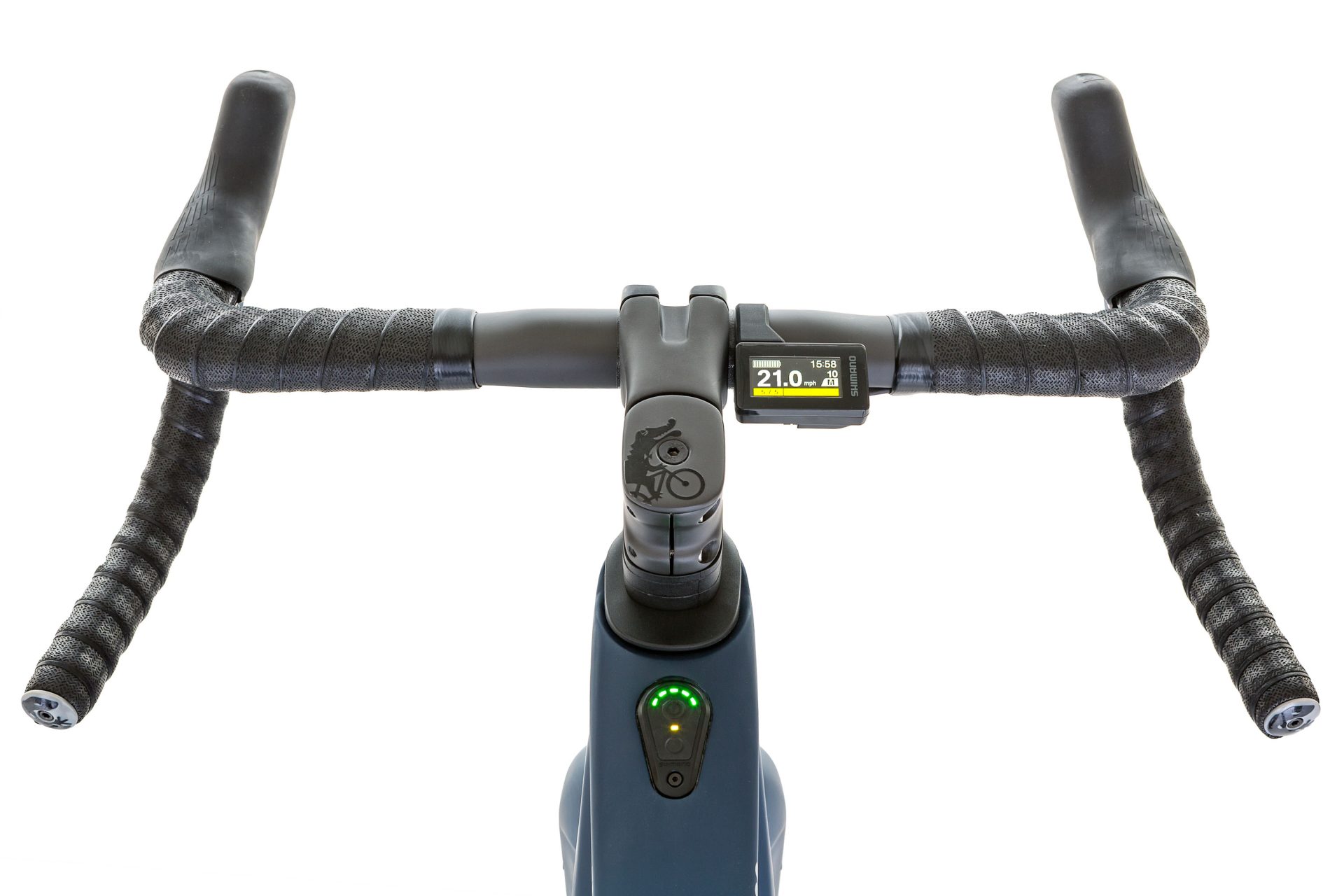
Remember Litespeed’s brief foray into carbon fiber road frames? How about Ellsworth’s collection of beach cruisers? And let’s not forget Full Force, the low-cost brand that Specialized experimented with back in the mid-90s.
Specialized at least had the wherewithal to not risk sullying its own brand equity with Full Force, instead wisely opting to pitch those bikes under a separate label. Full Force was an undeniable flop, but looking in the rearview mirror, “Specialized” never paid a price for it in terms of its reputation.
Moots is taking a much bigger risk here. It’s a vastly smaller company than Specialized, with less room for error, far fewer resources, and a brand name that is more tightly defined by a very short list of highly specific characteristics. In other words, a lot of different bikes can be a “Specialized,” but very few can be a “Moots.”
Former telecommunications executive Brent Whittington bought Moots back in 2019, and in an interview with Forbes magazine at the time, he expressed support for the brand’s steady-simmer growth trajectory.
“[Moots] was profitable before I bought the business, and it’s profitable now. If I’m growing the company 2 to 3% a year, I’m happy. I’ve seen enough [bike] brands who have screwed up, who have gone through bankruptcy, because they didn’t have the focus on the business, they didn’t keep their eye on the ball. I own 100% of this business – it would hurt if it crapped out.
“We build a bike and it rolls out with the Moots name on it. And because of our limited number [of bikes built per year], we price them accordingly to pay for our wages and our team. We don’t discount. All of the bikes are hand built in Steamboat Springs, Colorado, and we don’t want to lose that. From a growth perspective, we’re not trying to blow the doors off – I’m happy with slow and steady.”
Whittington purportedly sold all but 20% of Moots to a group of Texas-based investors last year, right at the heart of the COVID-fueled cycling boom. Are those new owners as comfortable taking things nice and easy, or are they more interested in a more steeply upward trajectory? Even if you take Whittington at his word, the fundamental nature of investors is they want a return on their investment.
I see this situation as being no different from a homeowner looking to tap into the equity of their house. They invested the money many years ago, their asset has appreciated in value, and they’re now looking to cash in some of that benefit. Ideally, that would be by reinvesting into the very thing that earned them that money in the first place: kitchen and bathroom remodels, a sizable addition, and so forth. If done correctly, it only adds further value.
When done incorrectly, though, all you’re doing is throwing away the gains you’ve spent years slowly and painfully building, like the equivalent of burning the equity in a beautiful historic Victorian-era mansion and using it to cover the whole thing in gold leaf to draw in some curious tourists and make a quick buck.
One is a smart long-term play; the other is a get-rich-quick scheme that isn’t likely to end well.
Which scenario are we looking at here with Moots and this new Express? My adoration for the Moots brand tells me to hope for the former, but my experience tells me to brace for the latter.
I hope I’m wrong. Time will tell.
More information on the new Express can be found at www.moots.com.
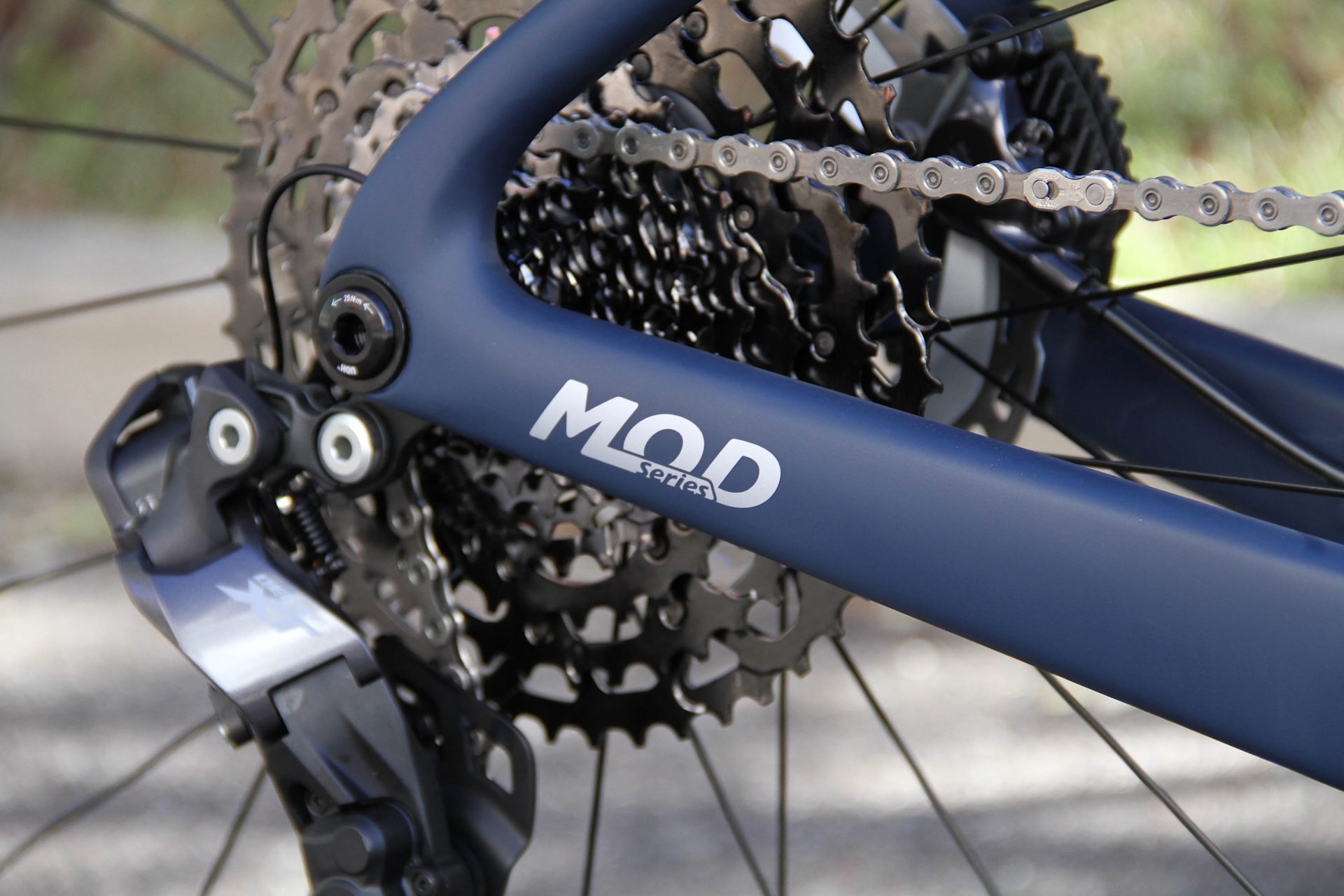
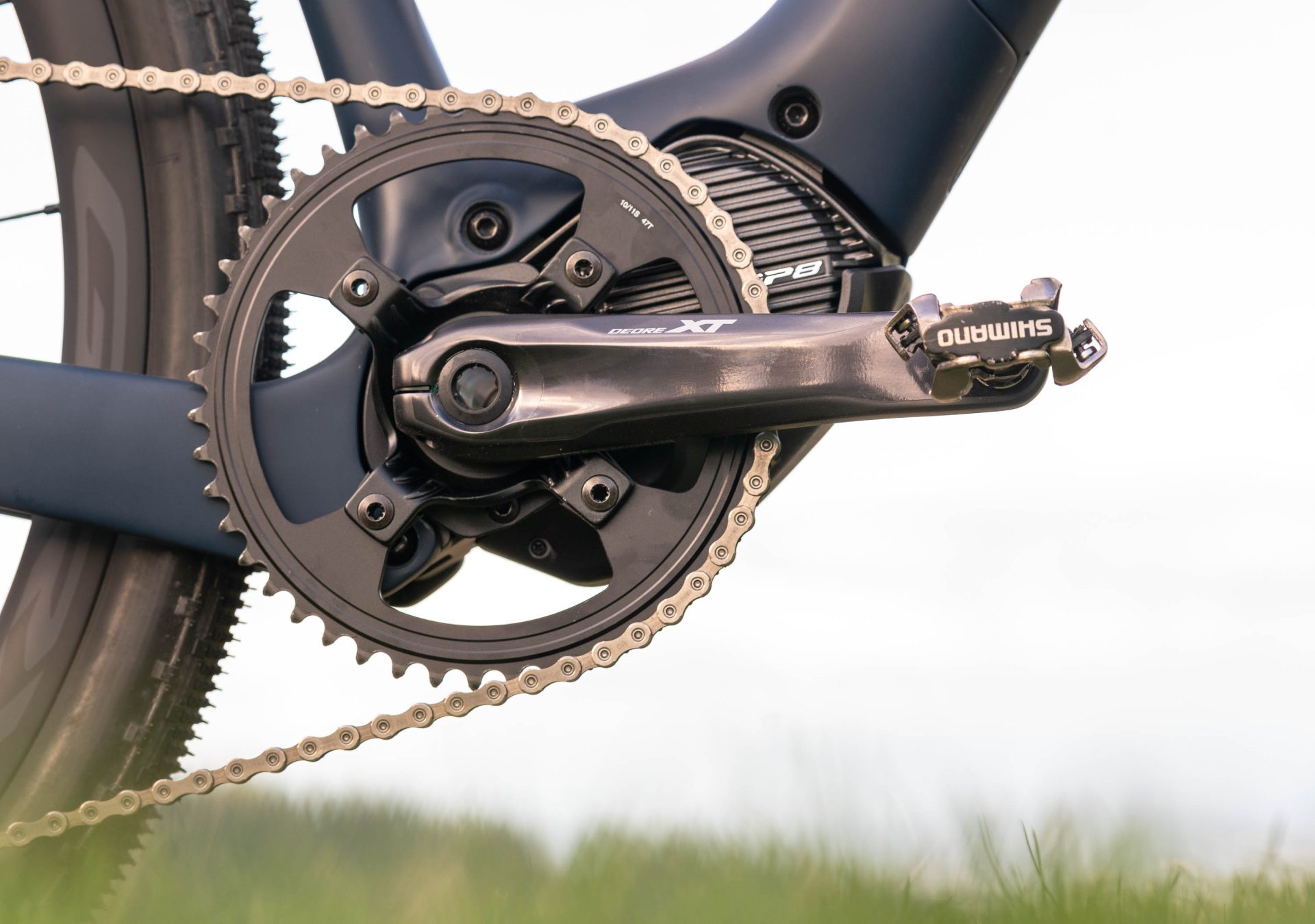

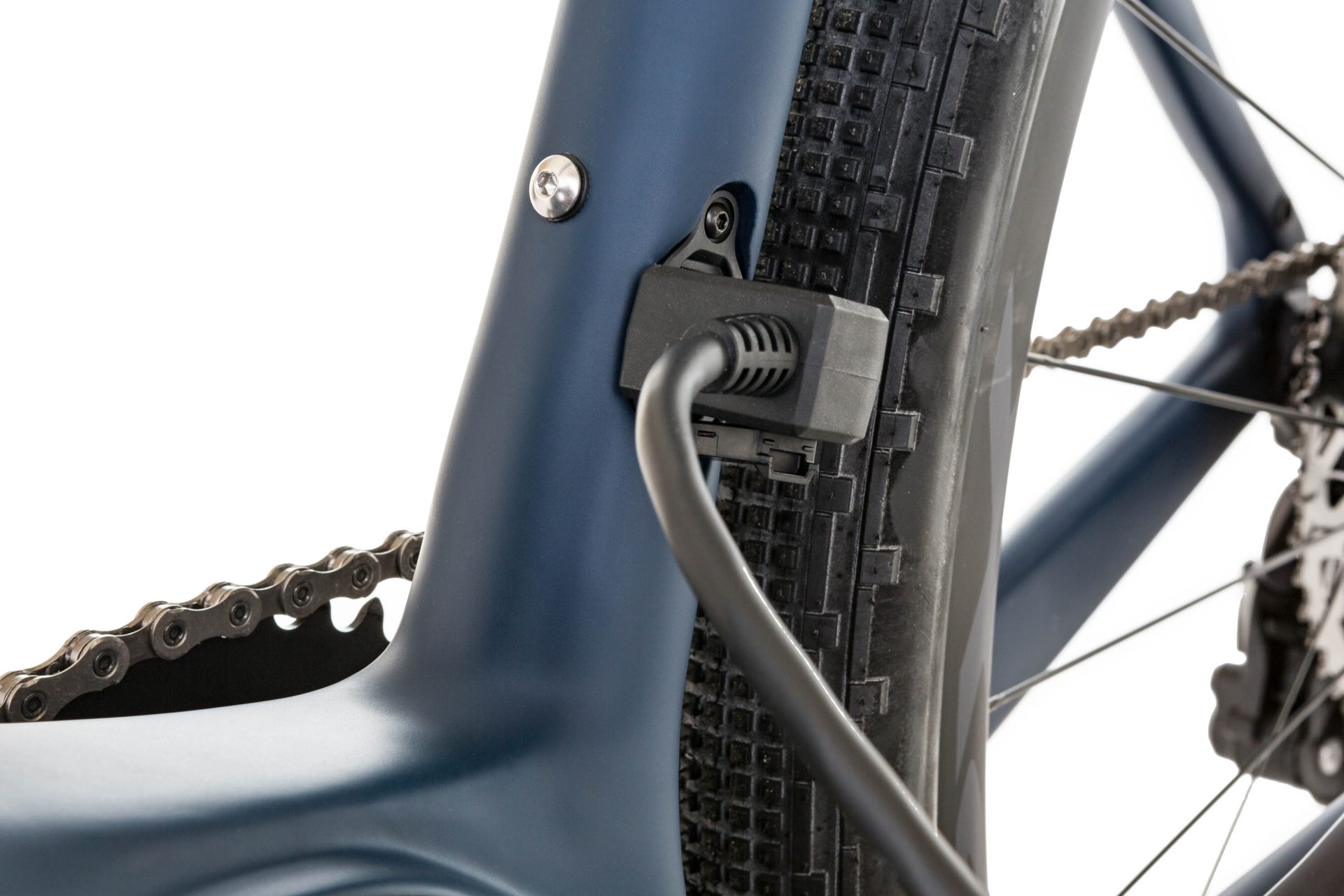

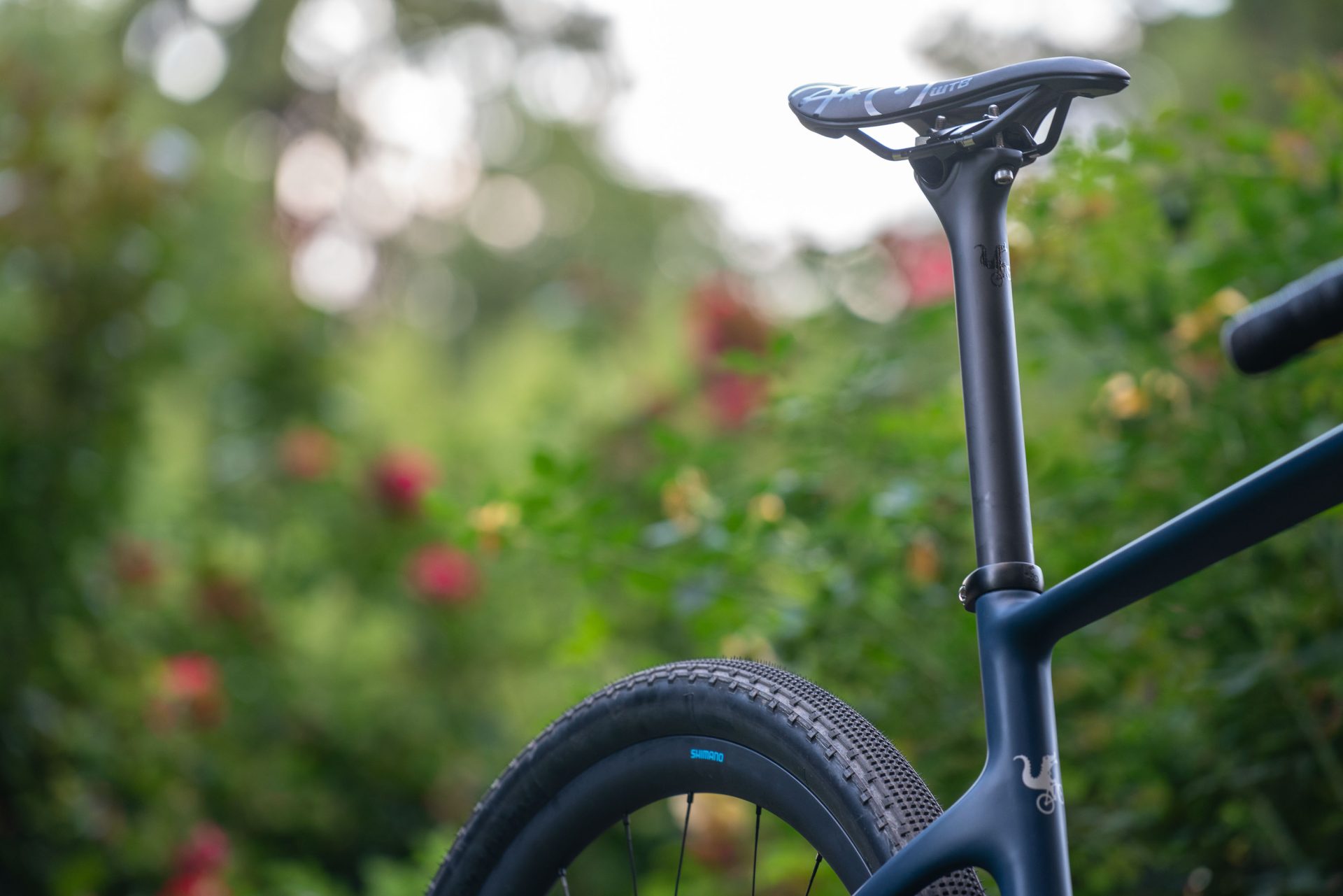
What did you think of this story?
